IFN600 Understanding Research: Women in Leadership, Roles and Biases
VerifiedAdded on 2023/03/31
|12
|2267
|68
Project
AI Summary
This research proposal aims to investigate the under-representation of women in leadership roles and the underlying biases contributing to this disparity, particularly within the Australian workplace context. It identifies the problem as a persistent issue despite diversity efforts, supported by statistics indicating women's over-representation in low-paying jobs and significant absence in leadership positions. The proposal seeks to understand the nuances of gender sensitivity and equal treatment, addressing gaps in existing literature regarding social biases and discriminatory practices. Research questions focus on identifying factors responsible for skewed representation and discriminatory elements restricting career growth. The methodology employs a positivism philosophy within Sauder’s onion model, utilizing an inductive approach with mixed quantitative and qualitative methods, including interviews and surveys, for data collection and thematic analysis. Ethical considerations are emphasized throughout the research process. The expected outcomes include building a knowledge base on the correlation between leadership roles and women, highlighting discrimination issues, and informing human resource management strategies. This research is a valuable resource for students; Desklib offers a platform with similar solved assignments and past papers.
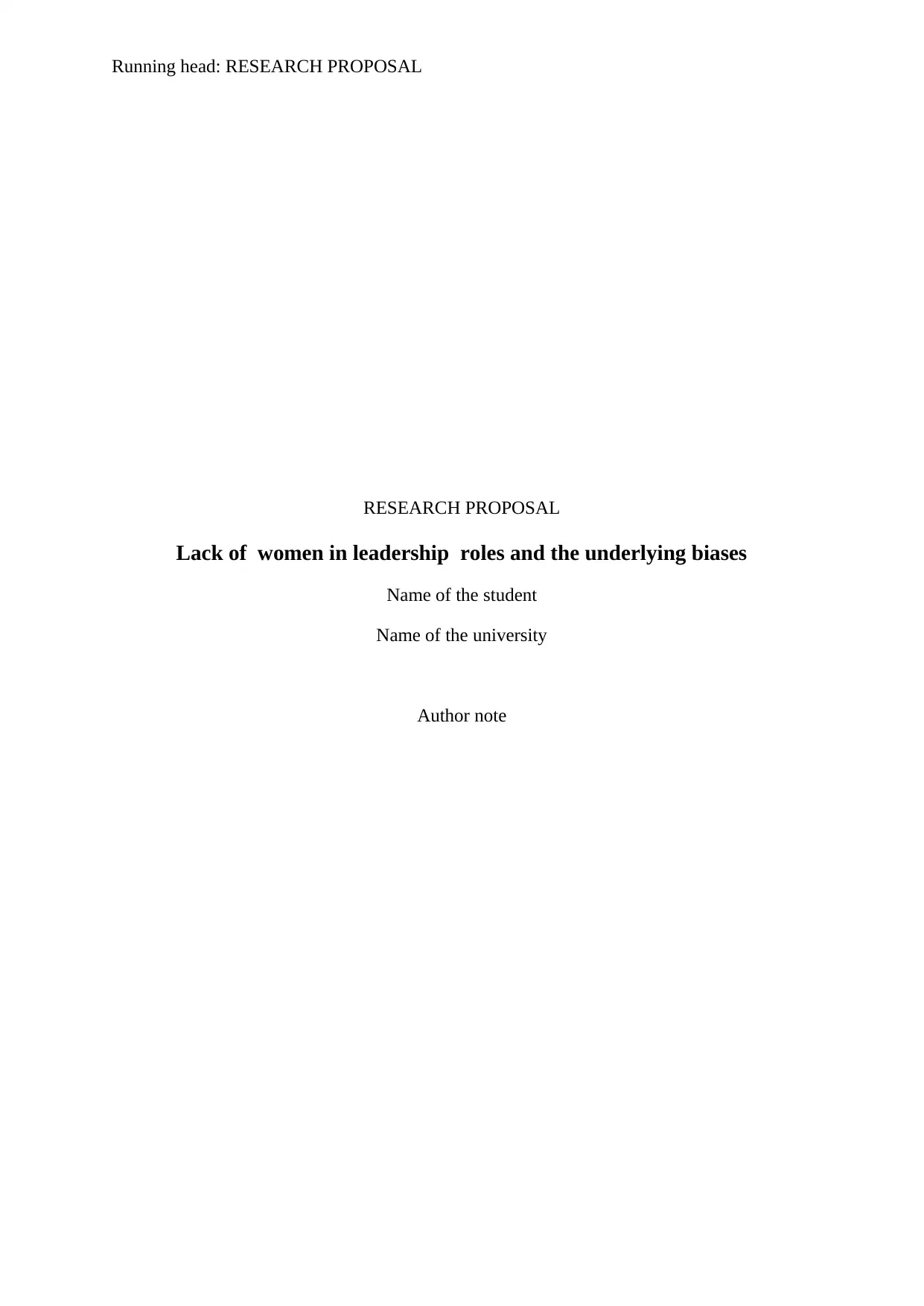
Running head: RESEARCH PROPOSAL
RESEARCH PROPOSAL
Lack of women in leadership roles and the underlying biases
Name of the student
Name of the university
Author note
RESEARCH PROPOSAL
Lack of women in leadership roles and the underlying biases
Name of the student
Name of the university
Author note
Paraphrase This Document
Need a fresh take? Get an instant paraphrase of this document with our AI Paraphraser
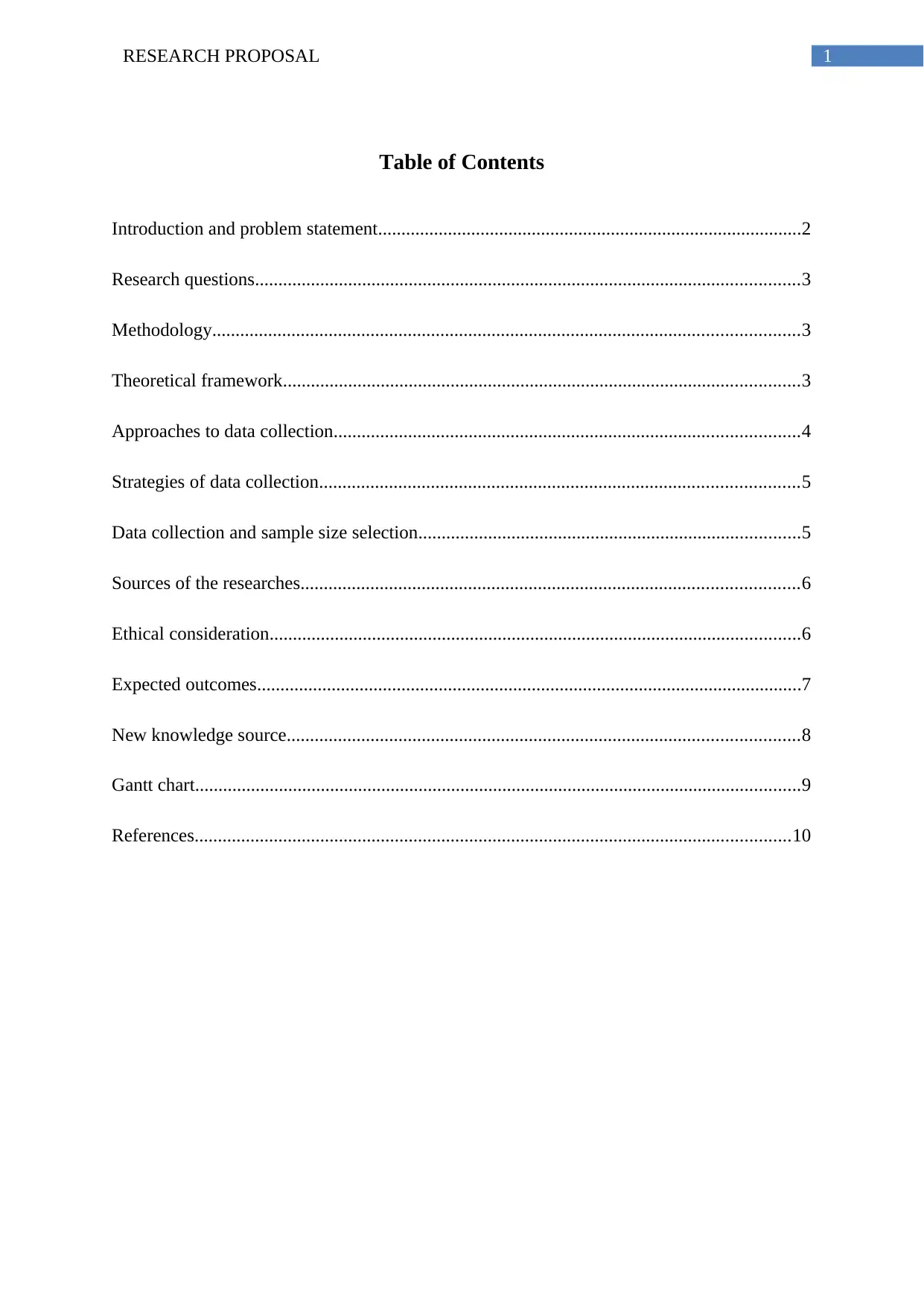
1RESEARCH PROPOSAL
Table of Contents
Introduction and problem statement...........................................................................................2
Research questions.....................................................................................................................3
Methodology..............................................................................................................................3
Theoretical framework...............................................................................................................3
Approaches to data collection....................................................................................................4
Strategies of data collection.......................................................................................................5
Data collection and sample size selection..................................................................................5
Sources of the researches...........................................................................................................6
Ethical consideration..................................................................................................................6
Expected outcomes.....................................................................................................................7
New knowledge source..............................................................................................................8
Gantt chart..................................................................................................................................9
References................................................................................................................................10
Table of Contents
Introduction and problem statement...........................................................................................2
Research questions.....................................................................................................................3
Methodology..............................................................................................................................3
Theoretical framework...............................................................................................................3
Approaches to data collection....................................................................................................4
Strategies of data collection.......................................................................................................5
Data collection and sample size selection..................................................................................5
Sources of the researches...........................................................................................................6
Ethical consideration..................................................................................................................6
Expected outcomes.....................................................................................................................7
New knowledge source..............................................................................................................8
Gantt chart..................................................................................................................................9
References................................................................................................................................10
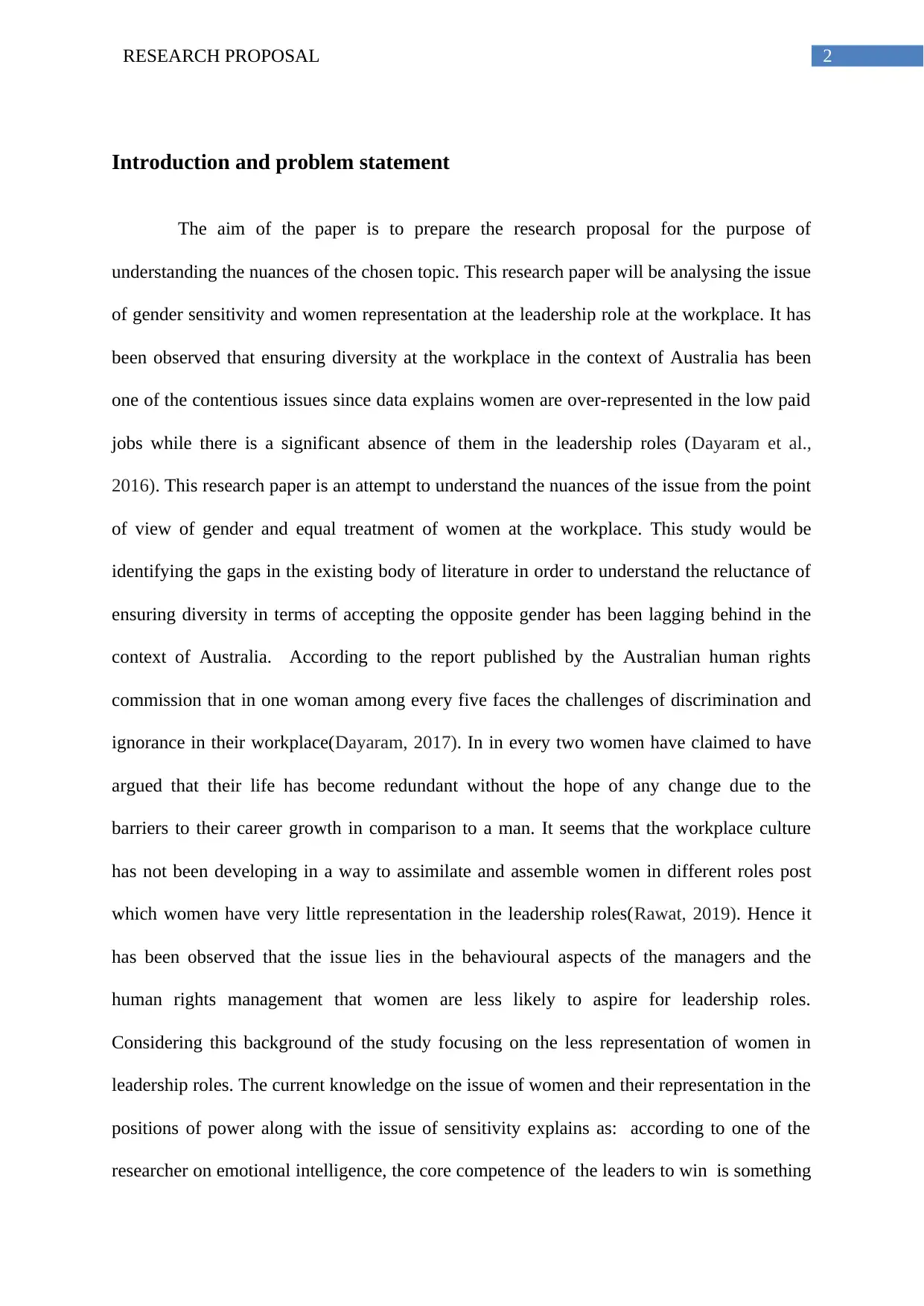
2RESEARCH PROPOSAL
Introduction and problem statement
The aim of the paper is to prepare the research proposal for the purpose of
understanding the nuances of the chosen topic. This research paper will be analysing the issue
of gender sensitivity and women representation at the leadership role at the workplace. It has
been observed that ensuring diversity at the workplace in the context of Australia has been
one of the contentious issues since data explains women are over-represented in the low paid
jobs while there is a significant absence of them in the leadership roles (Dayaram et al.,
2016). This research paper is an attempt to understand the nuances of the issue from the point
of view of gender and equal treatment of women at the workplace. This study would be
identifying the gaps in the existing body of literature in order to understand the reluctance of
ensuring diversity in terms of accepting the opposite gender has been lagging behind in the
context of Australia. According to the report published by the Australian human rights
commission that in one woman among every five faces the challenges of discrimination and
ignorance in their workplace(Dayaram, 2017). In in every two women have claimed to have
argued that their life has become redundant without the hope of any change due to the
barriers to their career growth in comparison to a man. It seems that the workplace culture
has not been developing in a way to assimilate and assemble women in different roles post
which women have very little representation in the leadership roles(Rawat, 2019). Hence it
has been observed that the issue lies in the behavioural aspects of the managers and the
human rights management that women are less likely to aspire for leadership roles.
Considering this background of the study focusing on the less representation of women in
leadership roles. The current knowledge on the issue of women and their representation in the
positions of power along with the issue of sensitivity explains as: according to one of the
researcher on emotional intelligence, the core competence of the leaders to win is something
Introduction and problem statement
The aim of the paper is to prepare the research proposal for the purpose of
understanding the nuances of the chosen topic. This research paper will be analysing the issue
of gender sensitivity and women representation at the leadership role at the workplace. It has
been observed that ensuring diversity at the workplace in the context of Australia has been
one of the contentious issues since data explains women are over-represented in the low paid
jobs while there is a significant absence of them in the leadership roles (Dayaram et al.,
2016). This research paper is an attempt to understand the nuances of the issue from the point
of view of gender and equal treatment of women at the workplace. This study would be
identifying the gaps in the existing body of literature in order to understand the reluctance of
ensuring diversity in terms of accepting the opposite gender has been lagging behind in the
context of Australia. According to the report published by the Australian human rights
commission that in one woman among every five faces the challenges of discrimination and
ignorance in their workplace(Dayaram, 2017). In in every two women have claimed to have
argued that their life has become redundant without the hope of any change due to the
barriers to their career growth in comparison to a man. It seems that the workplace culture
has not been developing in a way to assimilate and assemble women in different roles post
which women have very little representation in the leadership roles(Rawat, 2019). Hence it
has been observed that the issue lies in the behavioural aspects of the managers and the
human rights management that women are less likely to aspire for leadership roles.
Considering this background of the study focusing on the less representation of women in
leadership roles. The current knowledge on the issue of women and their representation in the
positions of power along with the issue of sensitivity explains as: according to one of the
researcher on emotional intelligence, the core competence of the leaders to win is something
⊘ This is a preview!⊘
Do you want full access?
Subscribe today to unlock all pages.

Trusted by 1+ million students worldwide
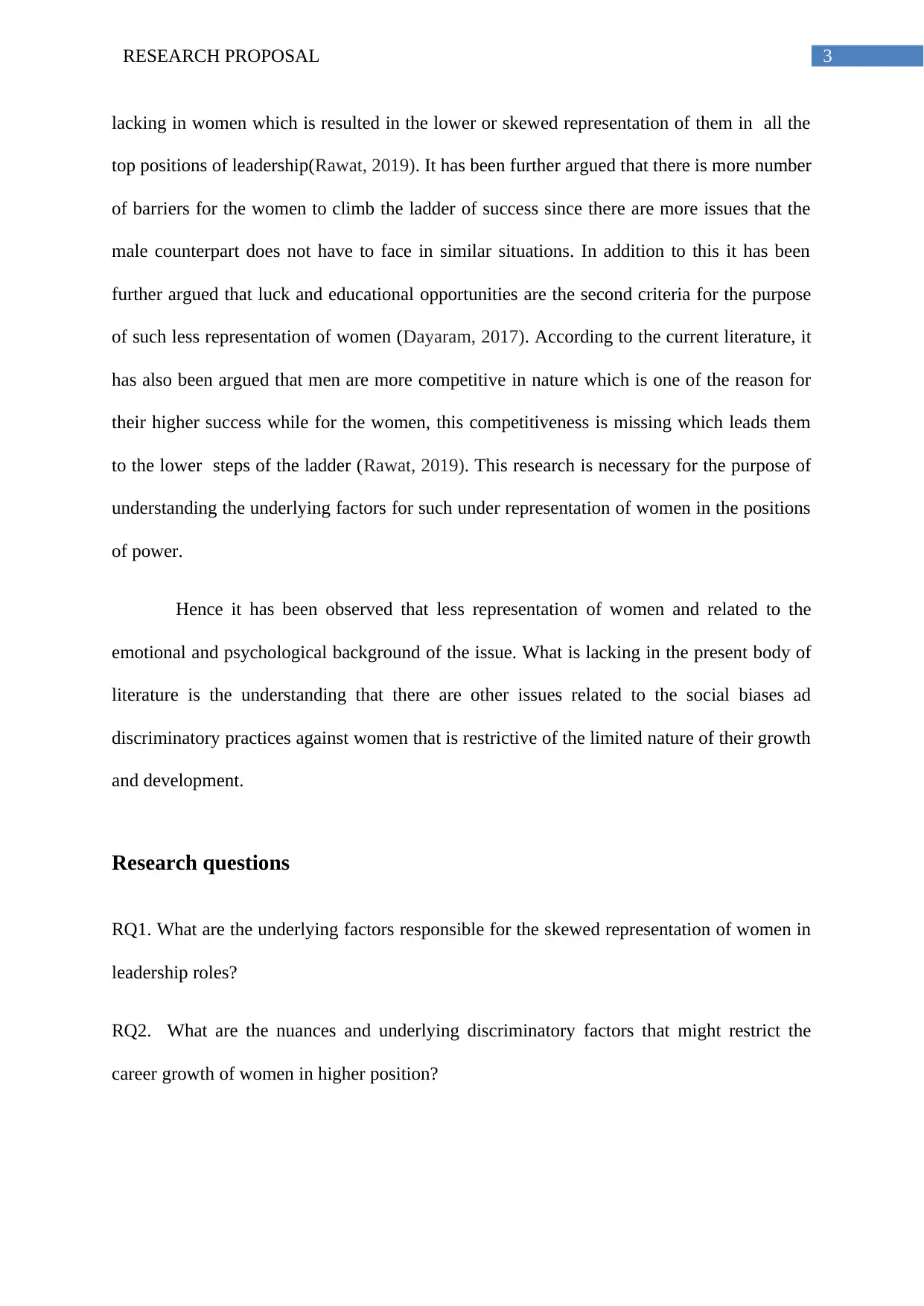
3RESEARCH PROPOSAL
lacking in women which is resulted in the lower or skewed representation of them in all the
top positions of leadership(Rawat, 2019). It has been further argued that there is more number
of barriers for the women to climb the ladder of success since there are more issues that the
male counterpart does not have to face in similar situations. In addition to this it has been
further argued that luck and educational opportunities are the second criteria for the purpose
of such less representation of women (Dayaram, 2017). According to the current literature, it
has also been argued that men are more competitive in nature which is one of the reason for
their higher success while for the women, this competitiveness is missing which leads them
to the lower steps of the ladder (Rawat, 2019). This research is necessary for the purpose of
understanding the underlying factors for such under representation of women in the positions
of power.
Hence it has been observed that less representation of women and related to the
emotional and psychological background of the issue. What is lacking in the present body of
literature is the understanding that there are other issues related to the social biases ad
discriminatory practices against women that is restrictive of the limited nature of their growth
and development.
Research questions
RQ1. What are the underlying factors responsible for the skewed representation of women in
leadership roles?
RQ2. What are the nuances and underlying discriminatory factors that might restrict the
career growth of women in higher position?
lacking in women which is resulted in the lower or skewed representation of them in all the
top positions of leadership(Rawat, 2019). It has been further argued that there is more number
of barriers for the women to climb the ladder of success since there are more issues that the
male counterpart does not have to face in similar situations. In addition to this it has been
further argued that luck and educational opportunities are the second criteria for the purpose
of such less representation of women (Dayaram, 2017). According to the current literature, it
has also been argued that men are more competitive in nature which is one of the reason for
their higher success while for the women, this competitiveness is missing which leads them
to the lower steps of the ladder (Rawat, 2019). This research is necessary for the purpose of
understanding the underlying factors for such under representation of women in the positions
of power.
Hence it has been observed that less representation of women and related to the
emotional and psychological background of the issue. What is lacking in the present body of
literature is the understanding that there are other issues related to the social biases ad
discriminatory practices against women that is restrictive of the limited nature of their growth
and development.
Research questions
RQ1. What are the underlying factors responsible for the skewed representation of women in
leadership roles?
RQ2. What are the nuances and underlying discriminatory factors that might restrict the
career growth of women in higher position?
Paraphrase This Document
Need a fresh take? Get an instant paraphrase of this document with our AI Paraphraser
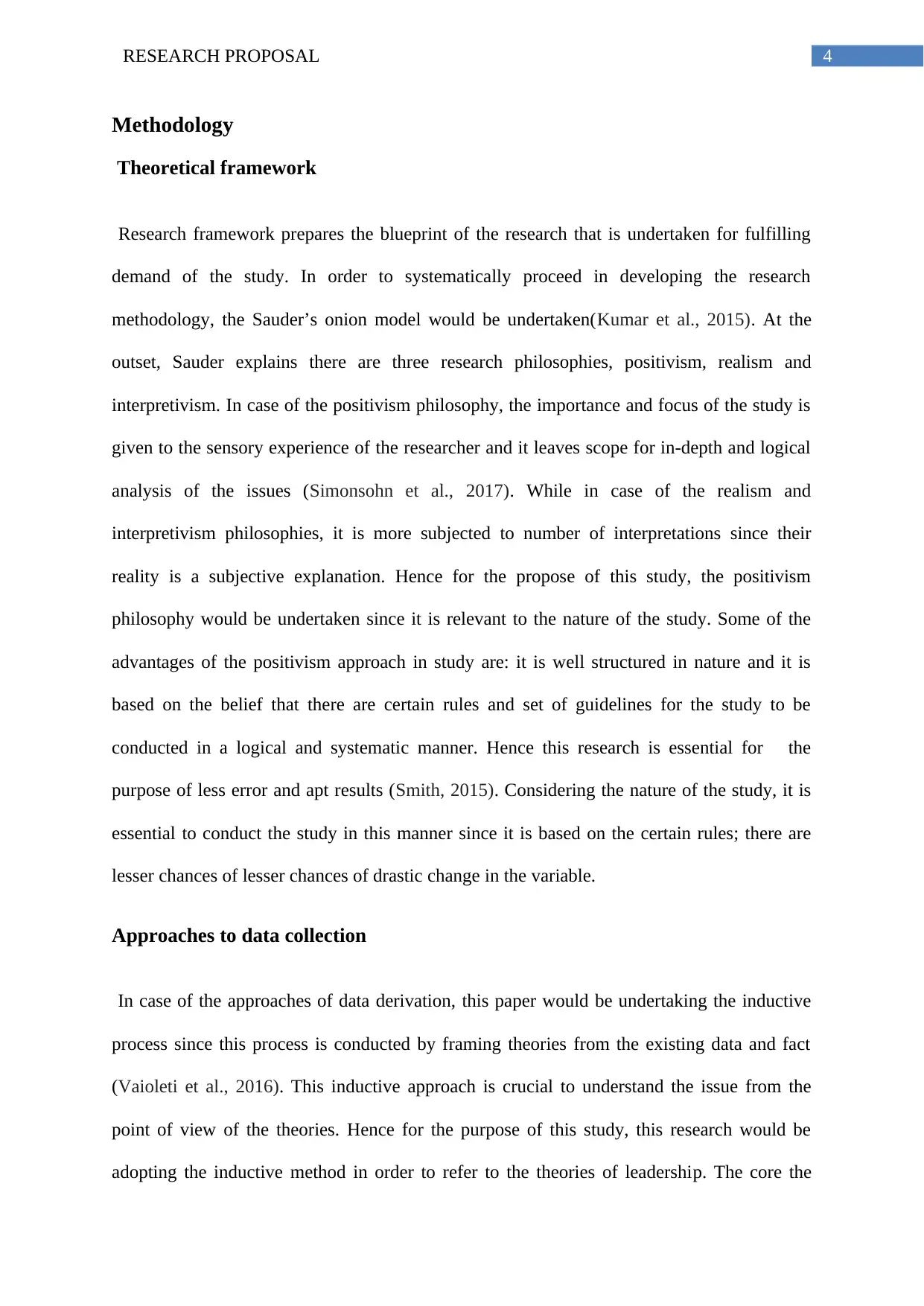
4RESEARCH PROPOSAL
Methodology
Theoretical framework
Research framework prepares the blueprint of the research that is undertaken for fulfilling
demand of the study. In order to systematically proceed in developing the research
methodology, the Sauder’s onion model would be undertaken(Kumar et al., 2015). At the
outset, Sauder explains there are three research philosophies, positivism, realism and
interpretivism. In case of the positivism philosophy, the importance and focus of the study is
given to the sensory experience of the researcher and it leaves scope for in-depth and logical
analysis of the issues (Simonsohn et al., 2017). While in case of the realism and
interpretivism philosophies, it is more subjected to number of interpretations since their
reality is a subjective explanation. Hence for the propose of this study, the positivism
philosophy would be undertaken since it is relevant to the nature of the study. Some of the
advantages of the positivism approach in study are: it is well structured in nature and it is
based on the belief that there are certain rules and set of guidelines for the study to be
conducted in a logical and systematic manner. Hence this research is essential for the
purpose of less error and apt results (Smith, 2015). Considering the nature of the study, it is
essential to conduct the study in this manner since it is based on the certain rules; there are
lesser chances of lesser chances of drastic change in the variable.
Approaches to data collection
In case of the approaches of data derivation, this paper would be undertaking the inductive
process since this process is conducted by framing theories from the existing data and fact
(Vaioleti et al., 2016). This inductive approach is crucial to understand the issue from the
point of view of the theories. Hence for the purpose of this study, this research would be
adopting the inductive method in order to refer to the theories of leadership. The core the
Methodology
Theoretical framework
Research framework prepares the blueprint of the research that is undertaken for fulfilling
demand of the study. In order to systematically proceed in developing the research
methodology, the Sauder’s onion model would be undertaken(Kumar et al., 2015). At the
outset, Sauder explains there are three research philosophies, positivism, realism and
interpretivism. In case of the positivism philosophy, the importance and focus of the study is
given to the sensory experience of the researcher and it leaves scope for in-depth and logical
analysis of the issues (Simonsohn et al., 2017). While in case of the realism and
interpretivism philosophies, it is more subjected to number of interpretations since their
reality is a subjective explanation. Hence for the propose of this study, the positivism
philosophy would be undertaken since it is relevant to the nature of the study. Some of the
advantages of the positivism approach in study are: it is well structured in nature and it is
based on the belief that there are certain rules and set of guidelines for the study to be
conducted in a logical and systematic manner. Hence this research is essential for the
purpose of less error and apt results (Smith, 2015). Considering the nature of the study, it is
essential to conduct the study in this manner since it is based on the certain rules; there are
lesser chances of lesser chances of drastic change in the variable.
Approaches to data collection
In case of the approaches of data derivation, this paper would be undertaking the inductive
process since this process is conducted by framing theories from the existing data and fact
(Vaioleti et al., 2016). This inductive approach is crucial to understand the issue from the
point of view of the theories. Hence for the purpose of this study, this research would be
adopting the inductive method in order to refer to the theories of leadership. The core the
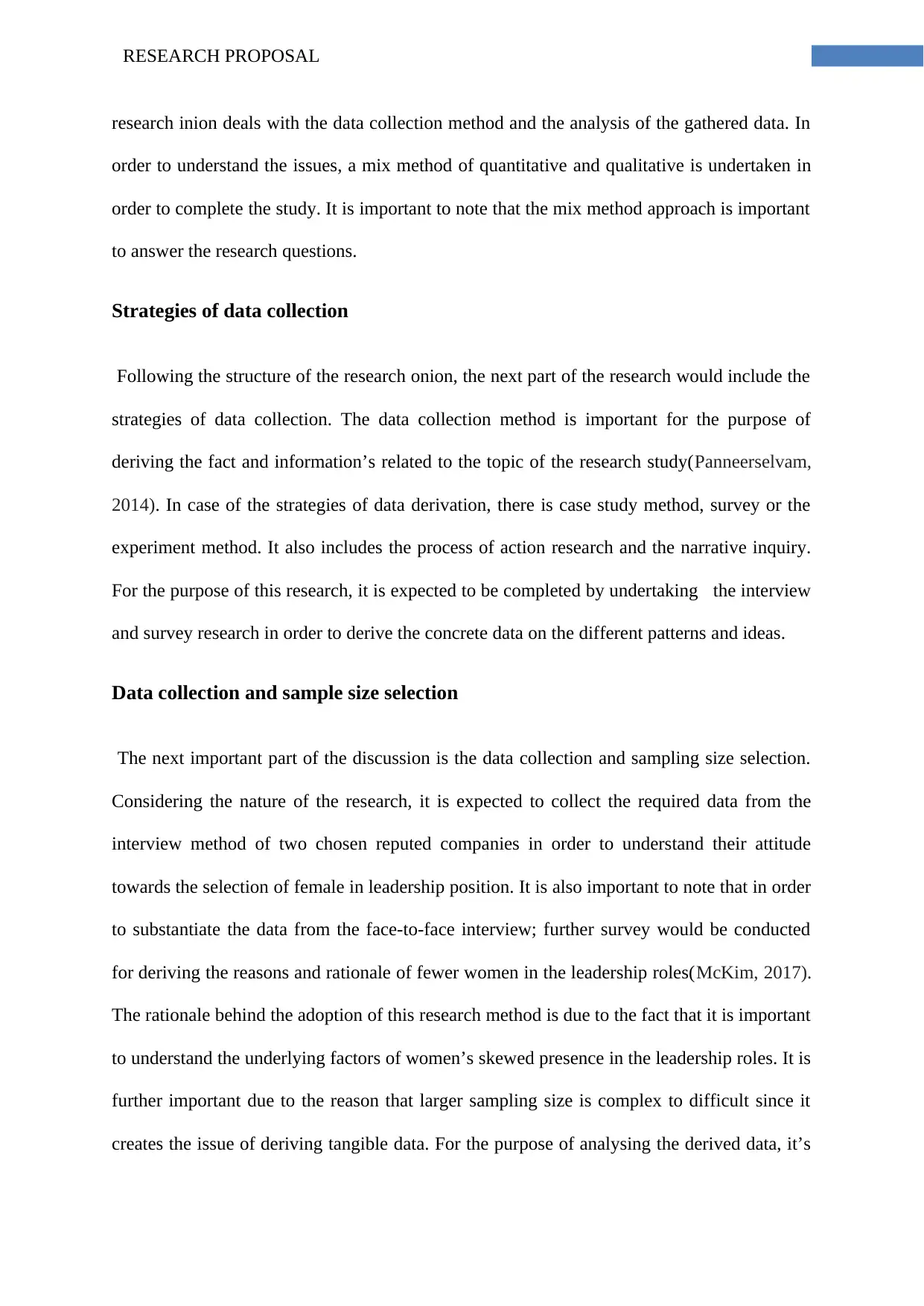
5RESEARCH PROPOSAL
research inion deals with the data collection method and the analysis of the gathered data. In
order to understand the issues, a mix method of quantitative and qualitative is undertaken in
order to complete the study. It is important to note that the mix method approach is important
to answer the research questions.
Strategies of data collection
Following the structure of the research onion, the next part of the research would include the
strategies of data collection. The data collection method is important for the purpose of
deriving the fact and information’s related to the topic of the research study(Panneerselvam,
2014). In case of the strategies of data derivation, there is case study method, survey or the
experiment method. It also includes the process of action research and the narrative inquiry.
For the purpose of this research, it is expected to be completed by undertaking the interview
and survey research in order to derive the concrete data on the different patterns and ideas.
Data collection and sample size selection
The next important part of the discussion is the data collection and sampling size selection.
Considering the nature of the research, it is expected to collect the required data from the
interview method of two chosen reputed companies in order to understand their attitude
towards the selection of female in leadership position. It is also important to note that in order
to substantiate the data from the face-to-face interview; further survey would be conducted
for deriving the reasons and rationale of fewer women in the leadership roles(McKim, 2017).
The rationale behind the adoption of this research method is due to the fact that it is important
to understand the underlying factors of women’s skewed presence in the leadership roles. It is
further important due to the reason that larger sampling size is complex to difficult since it
creates the issue of deriving tangible data. For the purpose of analysing the derived data, it’s
research inion deals with the data collection method and the analysis of the gathered data. In
order to understand the issues, a mix method of quantitative and qualitative is undertaken in
order to complete the study. It is important to note that the mix method approach is important
to answer the research questions.
Strategies of data collection
Following the structure of the research onion, the next part of the research would include the
strategies of data collection. The data collection method is important for the purpose of
deriving the fact and information’s related to the topic of the research study(Panneerselvam,
2014). In case of the strategies of data derivation, there is case study method, survey or the
experiment method. It also includes the process of action research and the narrative inquiry.
For the purpose of this research, it is expected to be completed by undertaking the interview
and survey research in order to derive the concrete data on the different patterns and ideas.
Data collection and sample size selection
The next important part of the discussion is the data collection and sampling size selection.
Considering the nature of the research, it is expected to collect the required data from the
interview method of two chosen reputed companies in order to understand their attitude
towards the selection of female in leadership position. It is also important to note that in order
to substantiate the data from the face-to-face interview; further survey would be conducted
for deriving the reasons and rationale of fewer women in the leadership roles(McKim, 2017).
The rationale behind the adoption of this research method is due to the fact that it is important
to understand the underlying factors of women’s skewed presence in the leadership roles. It is
further important due to the reason that larger sampling size is complex to difficult since it
creates the issue of deriving tangible data. For the purpose of analysing the derived data, it’s
⊘ This is a preview!⊘
Do you want full access?
Subscribe today to unlock all pages.

Trusted by 1+ million students worldwide
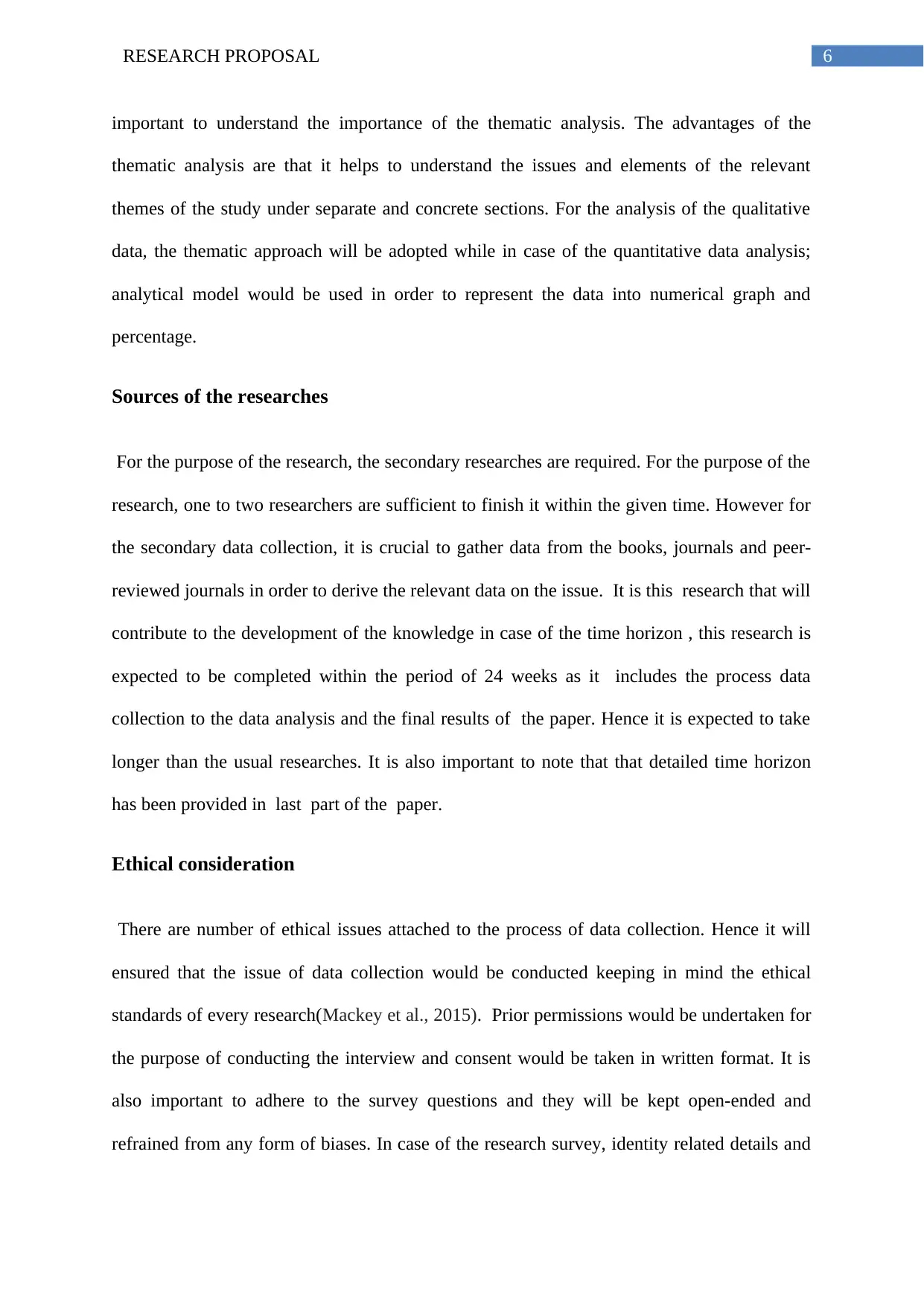
6RESEARCH PROPOSAL
important to understand the importance of the thematic analysis. The advantages of the
thematic analysis are that it helps to understand the issues and elements of the relevant
themes of the study under separate and concrete sections. For the analysis of the qualitative
data, the thematic approach will be adopted while in case of the quantitative data analysis;
analytical model would be used in order to represent the data into numerical graph and
percentage.
Sources of the researches
For the purpose of the research, the secondary researches are required. For the purpose of the
research, one to two researchers are sufficient to finish it within the given time. However for
the secondary data collection, it is crucial to gather data from the books, journals and peer-
reviewed journals in order to derive the relevant data on the issue. It is this research that will
contribute to the development of the knowledge in case of the time horizon , this research is
expected to be completed within the period of 24 weeks as it includes the process data
collection to the data analysis and the final results of the paper. Hence it is expected to take
longer than the usual researches. It is also important to note that that detailed time horizon
has been provided in last part of the paper.
Ethical consideration
There are number of ethical issues attached to the process of data collection. Hence it will
ensured that the issue of data collection would be conducted keeping in mind the ethical
standards of every research(Mackey et al., 2015). Prior permissions would be undertaken for
the purpose of conducting the interview and consent would be taken in written format. It is
also important to adhere to the survey questions and they will be kept open-ended and
refrained from any form of biases. In case of the research survey, identity related details and
important to understand the importance of the thematic analysis. The advantages of the
thematic analysis are that it helps to understand the issues and elements of the relevant
themes of the study under separate and concrete sections. For the analysis of the qualitative
data, the thematic approach will be adopted while in case of the quantitative data analysis;
analytical model would be used in order to represent the data into numerical graph and
percentage.
Sources of the researches
For the purpose of the research, the secondary researches are required. For the purpose of the
research, one to two researchers are sufficient to finish it within the given time. However for
the secondary data collection, it is crucial to gather data from the books, journals and peer-
reviewed journals in order to derive the relevant data on the issue. It is this research that will
contribute to the development of the knowledge in case of the time horizon , this research is
expected to be completed within the period of 24 weeks as it includes the process data
collection to the data analysis and the final results of the paper. Hence it is expected to take
longer than the usual researches. It is also important to note that that detailed time horizon
has been provided in last part of the paper.
Ethical consideration
There are number of ethical issues attached to the process of data collection. Hence it will
ensured that the issue of data collection would be conducted keeping in mind the ethical
standards of every research(Mackey et al., 2015). Prior permissions would be undertaken for
the purpose of conducting the interview and consent would be taken in written format. It is
also important to adhere to the survey questions and they will be kept open-ended and
refrained from any form of biases. In case of the research survey, identity related details and
Paraphrase This Document
Need a fresh take? Get an instant paraphrase of this document with our AI Paraphraser
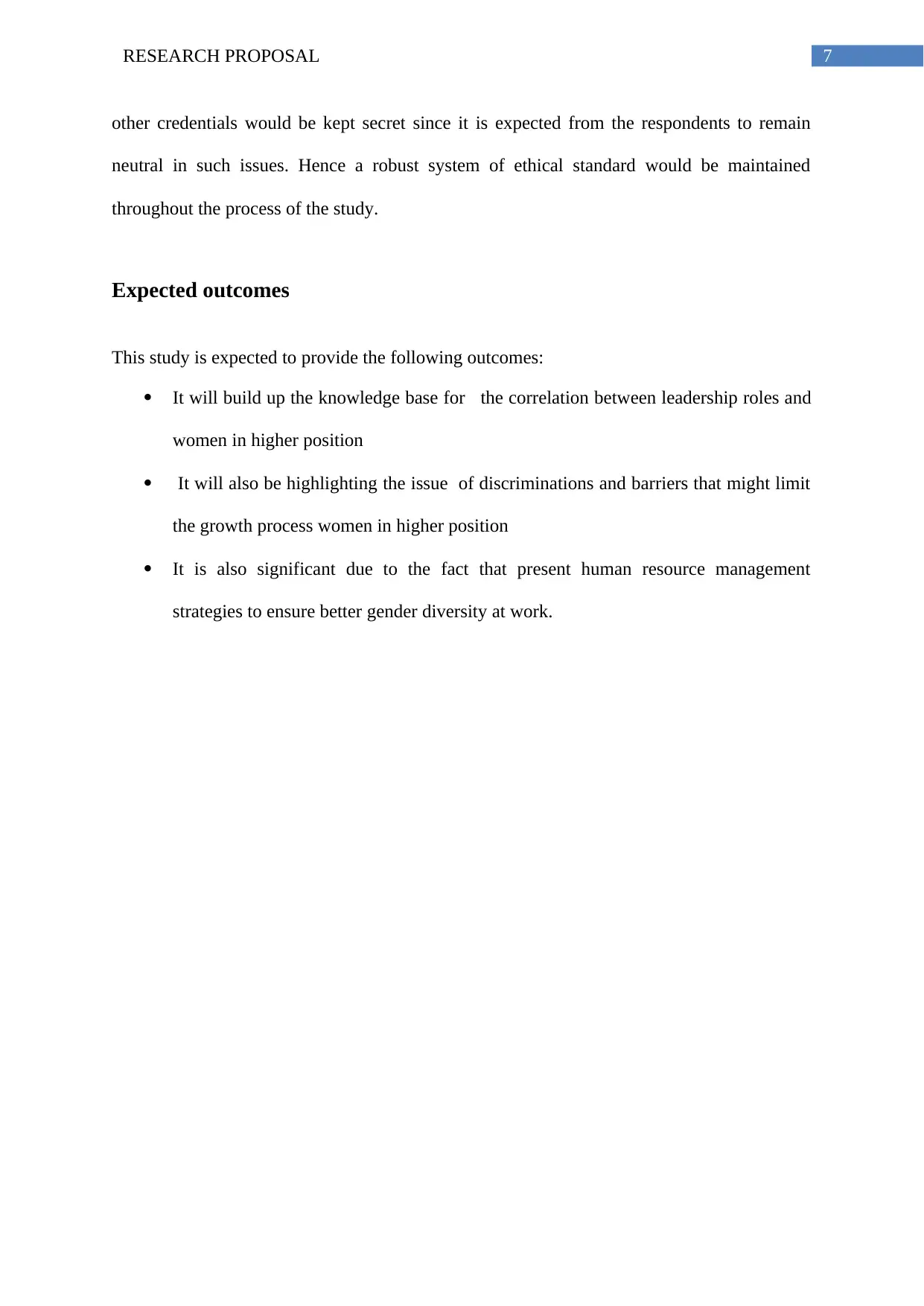
7RESEARCH PROPOSAL
other credentials would be kept secret since it is expected from the respondents to remain
neutral in such issues. Hence a robust system of ethical standard would be maintained
throughout the process of the study.
Expected outcomes
This study is expected to provide the following outcomes:
It will build up the knowledge base for the correlation between leadership roles and
women in higher position
It will also be highlighting the issue of discriminations and barriers that might limit
the growth process women in higher position
It is also significant due to the fact that present human resource management
strategies to ensure better gender diversity at work.
other credentials would be kept secret since it is expected from the respondents to remain
neutral in such issues. Hence a robust system of ethical standard would be maintained
throughout the process of the study.
Expected outcomes
This study is expected to provide the following outcomes:
It will build up the knowledge base for the correlation between leadership roles and
women in higher position
It will also be highlighting the issue of discriminations and barriers that might limit
the growth process women in higher position
It is also significant due to the fact that present human resource management
strategies to ensure better gender diversity at work.
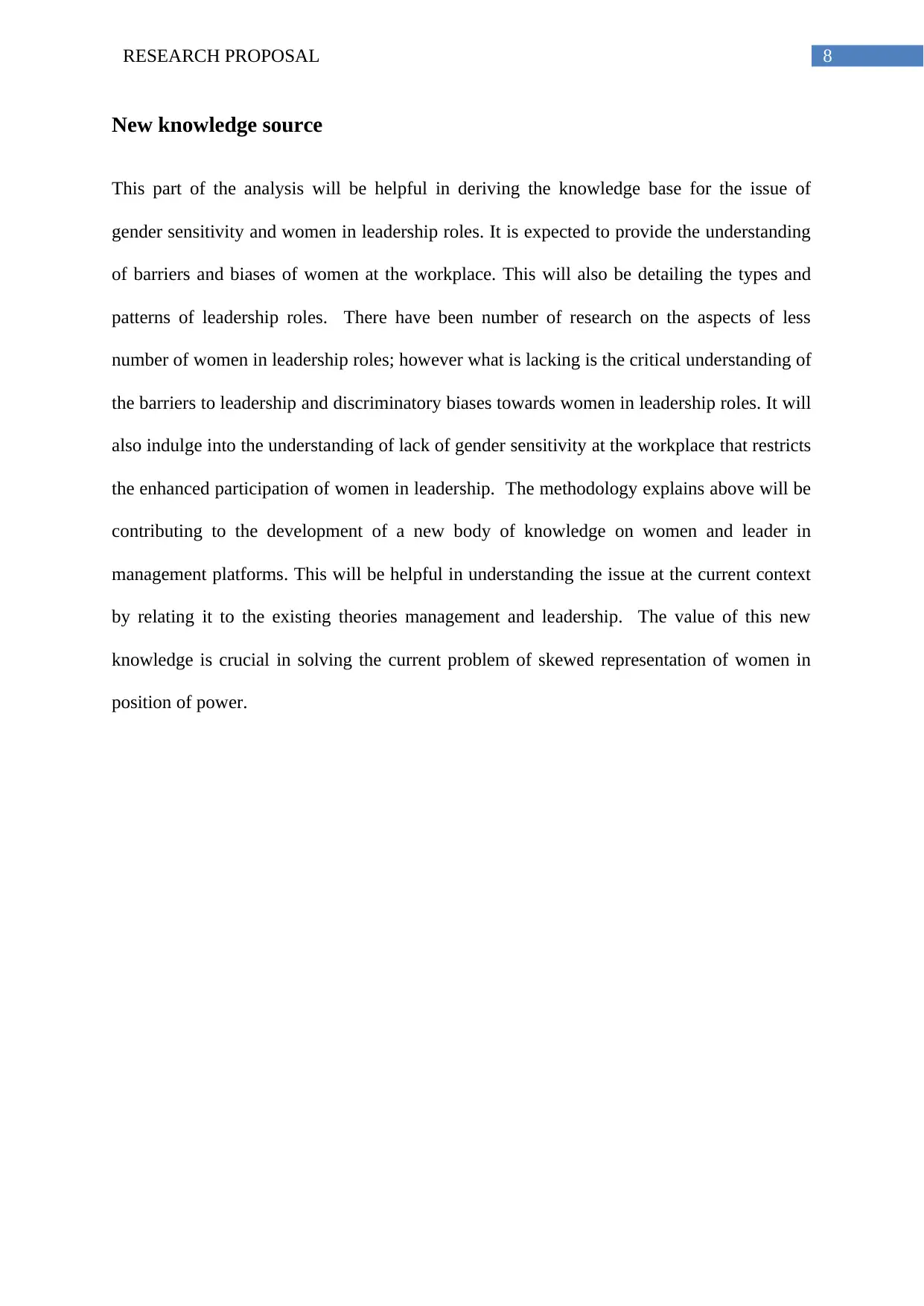
8RESEARCH PROPOSAL
New knowledge source
This part of the analysis will be helpful in deriving the knowledge base for the issue of
gender sensitivity and women in leadership roles. It is expected to provide the understanding
of barriers and biases of women at the workplace. This will also be detailing the types and
patterns of leadership roles. There have been number of research on the aspects of less
number of women in leadership roles; however what is lacking is the critical understanding of
the barriers to leadership and discriminatory biases towards women in leadership roles. It will
also indulge into the understanding of lack of gender sensitivity at the workplace that restricts
the enhanced participation of women in leadership. The methodology explains above will be
contributing to the development of a new body of knowledge on women and leader in
management platforms. This will be helpful in understanding the issue at the current context
by relating it to the existing theories management and leadership. The value of this new
knowledge is crucial in solving the current problem of skewed representation of women in
position of power.
New knowledge source
This part of the analysis will be helpful in deriving the knowledge base for the issue of
gender sensitivity and women in leadership roles. It is expected to provide the understanding
of barriers and biases of women at the workplace. This will also be detailing the types and
patterns of leadership roles. There have been number of research on the aspects of less
number of women in leadership roles; however what is lacking is the critical understanding of
the barriers to leadership and discriminatory biases towards women in leadership roles. It will
also indulge into the understanding of lack of gender sensitivity at the workplace that restricts
the enhanced participation of women in leadership. The methodology explains above will be
contributing to the development of a new body of knowledge on women and leader in
management platforms. This will be helpful in understanding the issue at the current context
by relating it to the existing theories management and leadership. The value of this new
knowledge is crucial in solving the current problem of skewed representation of women in
position of power.
⊘ This is a preview!⊘
Do you want full access?
Subscribe today to unlock all pages.

Trusted by 1+ million students worldwide
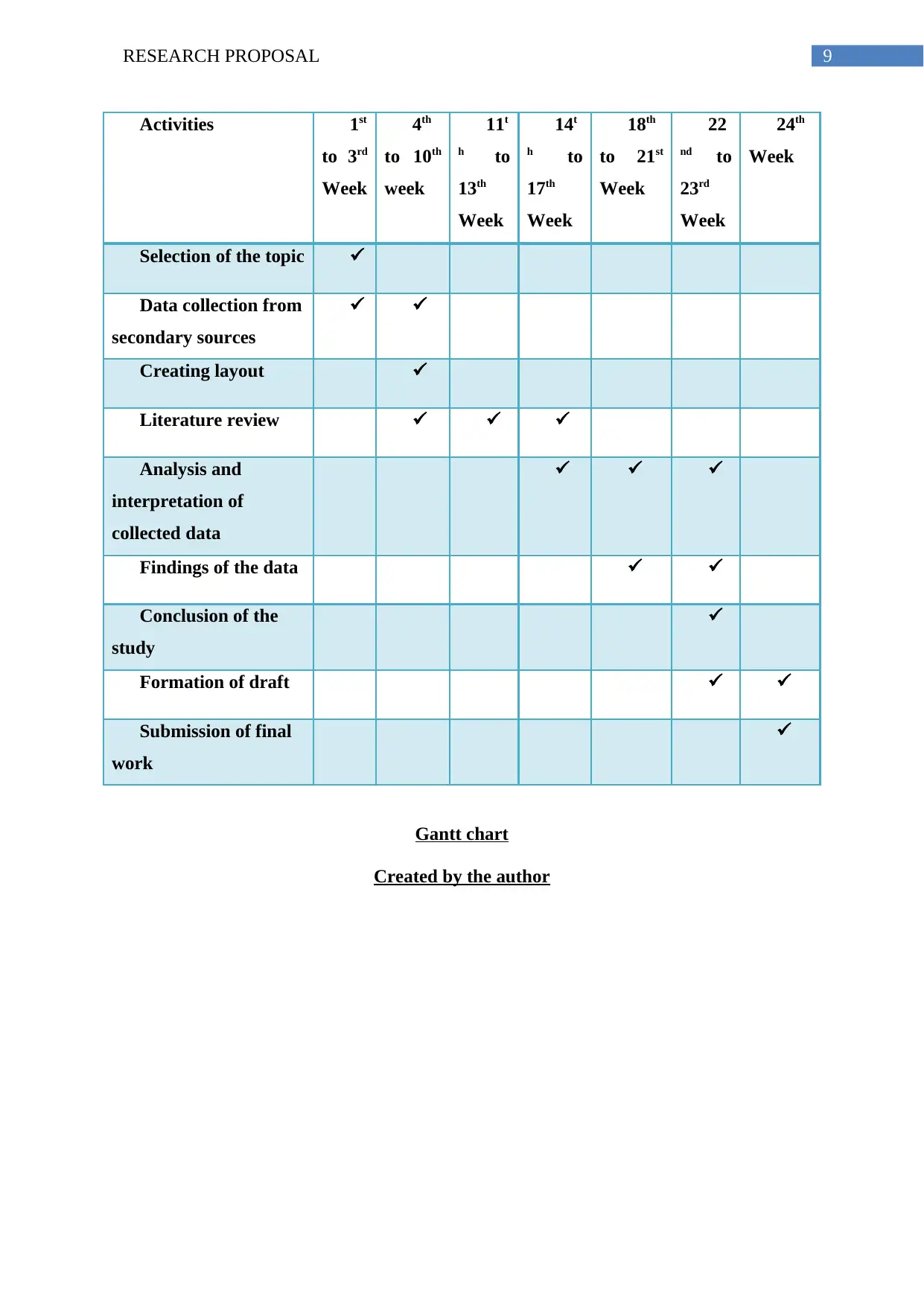
9RESEARCH PROPOSAL
Activities 1st
to 3rd
Week
4th
to 10th
week
11t
h to
13th
Week
14t
h to
17th
Week
18th
to 21st
Week
22
nd to
23rd
Week
24th
Week
Selection of the topic
Data collection from
secondary sources
Creating layout
Literature review
Analysis and
interpretation of
collected data
Findings of the data
Conclusion of the
study
Formation of draft
Submission of final
work
Gantt chart
Created by the author
Activities 1st
to 3rd
Week
4th
to 10th
week
11t
h to
13th
Week
14t
h to
17th
Week
18th
to 21st
Week
22
nd to
23rd
Week
24th
Week
Selection of the topic
Data collection from
secondary sources
Creating layout
Literature review
Analysis and
interpretation of
collected data
Findings of the data
Conclusion of the
study
Formation of draft
Submission of final
work
Gantt chart
Created by the author
Paraphrase This Document
Need a fresh take? Get an instant paraphrase of this document with our AI Paraphraser
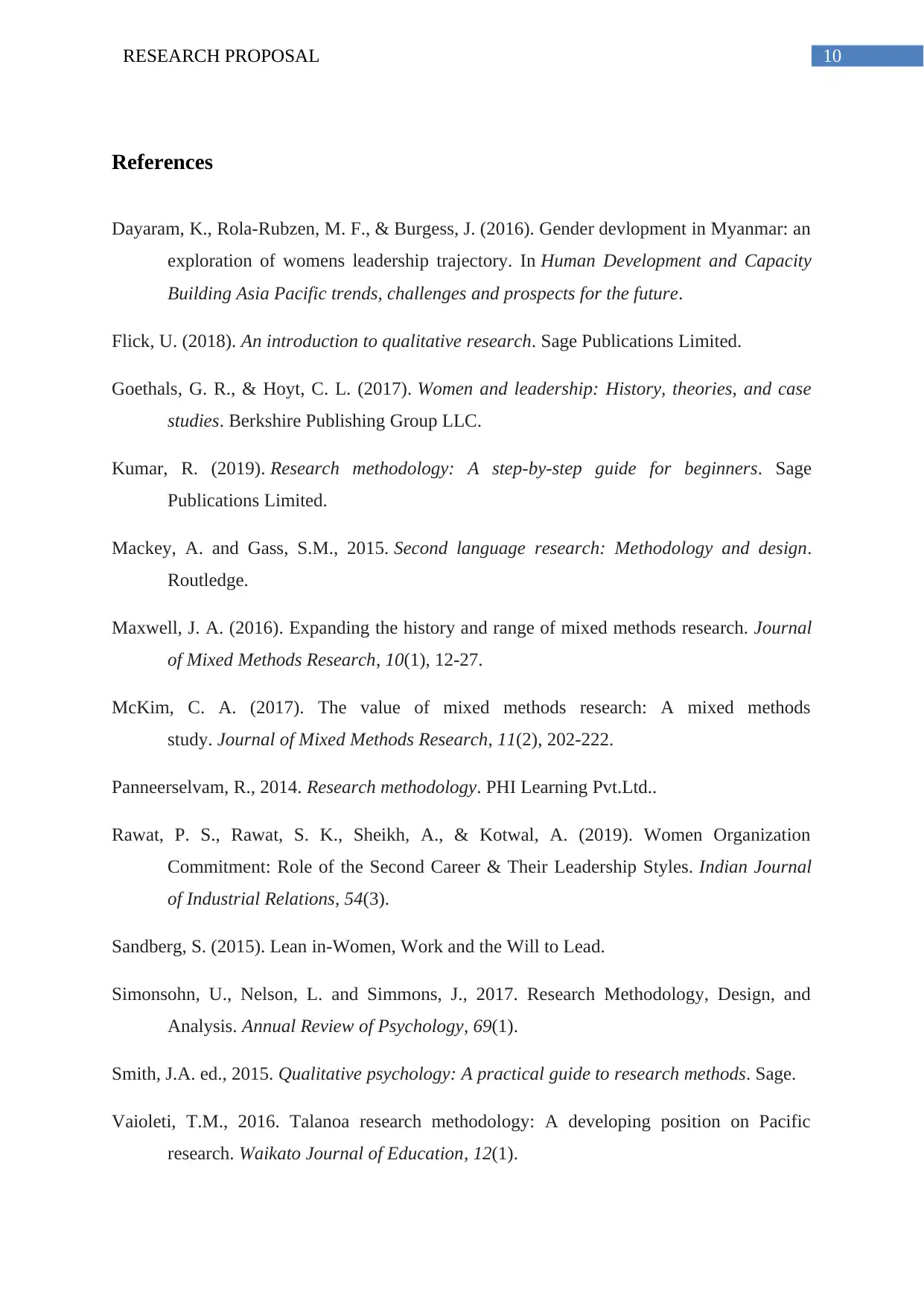
10RESEARCH PROPOSAL
References
Dayaram, K., Rola-Rubzen, M. F., & Burgess, J. (2016). Gender devlopment in Myanmar: an
exploration of womens leadership trajectory. In Human Development and Capacity
Building Asia Pacific trends, challenges and prospects for the future.
Flick, U. (2018). An introduction to qualitative research. Sage Publications Limited.
Goethals, G. R., & Hoyt, C. L. (2017). Women and leadership: History, theories, and case
studies. Berkshire Publishing Group LLC.
Kumar, R. (2019). Research methodology: A step-by-step guide for beginners. Sage
Publications Limited.
Mackey, A. and Gass, S.M., 2015. Second language research: Methodology and design.
Routledge.
Maxwell, J. A. (2016). Expanding the history and range of mixed methods research. Journal
of Mixed Methods Research, 10(1), 12-27.
McKim, C. A. (2017). The value of mixed methods research: A mixed methods
study. Journal of Mixed Methods Research, 11(2), 202-222.
Panneerselvam, R., 2014. Research methodology. PHI Learning Pvt.Ltd..
Rawat, P. S., Rawat, S. K., Sheikh, A., & Kotwal, A. (2019). Women Organization
Commitment: Role of the Second Career & Their Leadership Styles. Indian Journal
of Industrial Relations, 54(3).
Sandberg, S. (2015). Lean in-Women, Work and the Will to Lead.
Simonsohn, U., Nelson, L. and Simmons, J., 2017. Research Methodology, Design, and
Analysis. Annual Review of Psychology, 69(1).
Smith, J.A. ed., 2015. Qualitative psychology: A practical guide to research methods. Sage.
Vaioleti, T.M., 2016. Talanoa research methodology: A developing position on Pacific
research. Waikato Journal of Education, 12(1).
References
Dayaram, K., Rola-Rubzen, M. F., & Burgess, J. (2016). Gender devlopment in Myanmar: an
exploration of womens leadership trajectory. In Human Development and Capacity
Building Asia Pacific trends, challenges and prospects for the future.
Flick, U. (2018). An introduction to qualitative research. Sage Publications Limited.
Goethals, G. R., & Hoyt, C. L. (2017). Women and leadership: History, theories, and case
studies. Berkshire Publishing Group LLC.
Kumar, R. (2019). Research methodology: A step-by-step guide for beginners. Sage
Publications Limited.
Mackey, A. and Gass, S.M., 2015. Second language research: Methodology and design.
Routledge.
Maxwell, J. A. (2016). Expanding the history and range of mixed methods research. Journal
of Mixed Methods Research, 10(1), 12-27.
McKim, C. A. (2017). The value of mixed methods research: A mixed methods
study. Journal of Mixed Methods Research, 11(2), 202-222.
Panneerselvam, R., 2014. Research methodology. PHI Learning Pvt.Ltd..
Rawat, P. S., Rawat, S. K., Sheikh, A., & Kotwal, A. (2019). Women Organization
Commitment: Role of the Second Career & Their Leadership Styles. Indian Journal
of Industrial Relations, 54(3).
Sandberg, S. (2015). Lean in-Women, Work and the Will to Lead.
Simonsohn, U., Nelson, L. and Simmons, J., 2017. Research Methodology, Design, and
Analysis. Annual Review of Psychology, 69(1).
Smith, J.A. ed., 2015. Qualitative psychology: A practical guide to research methods. Sage.
Vaioleti, T.M., 2016. Talanoa research methodology: A developing position on Pacific
research. Waikato Journal of Education, 12(1).

11RESEARCH PROPOSAL
⊘ This is a preview!⊘
Do you want full access?
Subscribe today to unlock all pages.

Trusted by 1+ million students worldwide
1 out of 12
Related Documents
Your All-in-One AI-Powered Toolkit for Academic Success.
+13062052269
info@desklib.com
Available 24*7 on WhatsApp / Email
![[object Object]](/_next/static/media/star-bottom.7253800d.svg)
Unlock your academic potential
Copyright © 2020–2025 A2Z Services. All Rights Reserved. Developed and managed by ZUCOL.





